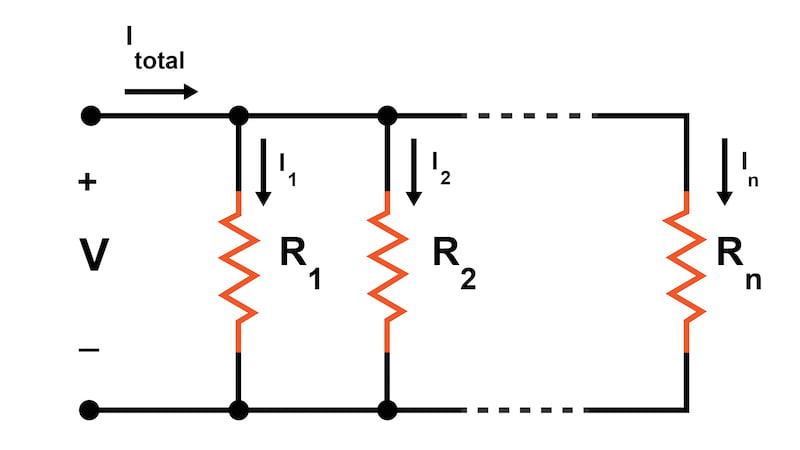Parallel Resistor Calculator
Calculate the equivalent resistance of up to six resistors in parallel with ease while learning how to calculate resistance in parallel and the parallel resistance formula.
Inputs
Output
How to Calculate the Equivalent Resistance of Resistors Connected in Parallel
Calculating the equivalent resistance (Req) of resistors in parallel (Figure 1) by hand can be tiresome.

Figure 1. Circuit schematic for resistors connected in parallel
This tool was designed to help you quickly calculate the equivalent resistance of up to 6 resistors connected in parallel. To use it, just specify how many parallel resistors there are and the resistance value for each one. If you have more than 6 resistors, simply use the calculator to determine the equivalent resistance of the first 6 resistors, and then plug that value in for R1 and add values for R7, R8, ..., R11 into the calculator in the R2, R3, ..., R6 input fields.
Calculating Resistance in Parallel Using Ohm's Law
The voltage (V) across all of the resistors in a parallel circuit is identical. This can be seen by observing that the parallel resistors share the same nodes. The current through each individual resistor, Rx, can be calculated using Ohm's law:
$$I_x = \frac{V}{R_x}$$
The total current through the parallel resistors is the sum of the individual currents:
$$I_{total} = I_1 + I_2 + I_3 + ... + I_n$$
The current through each individual resistor does not change when you add resistors in parallel because adding resistors in parallel does not affect the voltage across the resistors' terminals. What changes in the total current delivered by the power supply, not the current through one particular resistor.
Parallel Resistance Formula
From the total current equation, we can then derive an equation for the equivalent parallel resistance:
$$R_{eq} = \frac{V}{I_{total}} = \frac{V}{(\frac{V}{R_1} + \frac{V}{R_2} + \frac{V}{R_3} + ... + \frac{V}{R_n})}$$
From there, by simplifying the terms, we get:
$$R_{eq} = \frac{1}{(\frac{1}{R_1} + \frac{1}{R_2} + \frac{1}{R_3} + ... + \frac{1}{R_n})}$$
This is often expressed as:
$$\frac{1}{R_{eq}} = \frac{1}{R_1} + \frac{1}{R_2} + \frac{1}{R_3} + ... + \frac{1}{R_n}$$
When you have only two resistors in parallel, the equivalent resistance can be easily calculated using this equation:
$$R_{eq} = \frac{R_1\times R_2}{R_1+R_2}$$
Applications for Parallel Resistors
Resistors in parallel always result in an equivalent resistance that is lower than the resistance of each individual resistor. Resistors in series, on the other hand, are equivalent to one resistor whose resistance is the sum of each individual resistor. If you think about it, the lower equivalent resistance for parallel resistors makes sense. If you apply a voltage across a resistor, a certain amount of current flows. If you add another resistor in parallel with the first one, you have essentially opened up a new channel through which more current can flow. No matter how high the resistance of the second resistor is, the total current flowing from the power supply will be at least slightly higher than the current through the single resistor. And if the total current is higher, the overall equivalent resistance must be lower.
Multiple parallel resistors are often used to create a smaller effective resistance when you don't have the desired resistor value readily available. This is handy when you need a specific resistance value and don't have an appropriate part readily available. For example, you can easily calculate the equivalent resistance when you have two identical resistors in parallel: it is half of the individual resistance. If you need about 500 Ω to get the desired brightness out of an LED circuit, you can use two 1 kΩ resistors in parallel.
Using parallel resistors can also allow you to minimize the power consumption of any individual resistor in the circuit. Imagine our LED circuit example connected to a 16 V supply with 1 V dropped across the LED. A single 500 Ω would consume 450 mW (152 / 500). But, using two 1 kΩ resistors in parallel would limit the individual resistor power consumption to 225 mW, thereby allowing the use of standard 0.25 W resistors.








Also try using https://nortonthevenin.tech/, saves me a lot of time
This lacks notations or conversion options. Its not hard to code a drop down menu and adds the conversion equationa. None of your calculators do I’ve seen
Where is the kilo to ohm or ma to kilo?